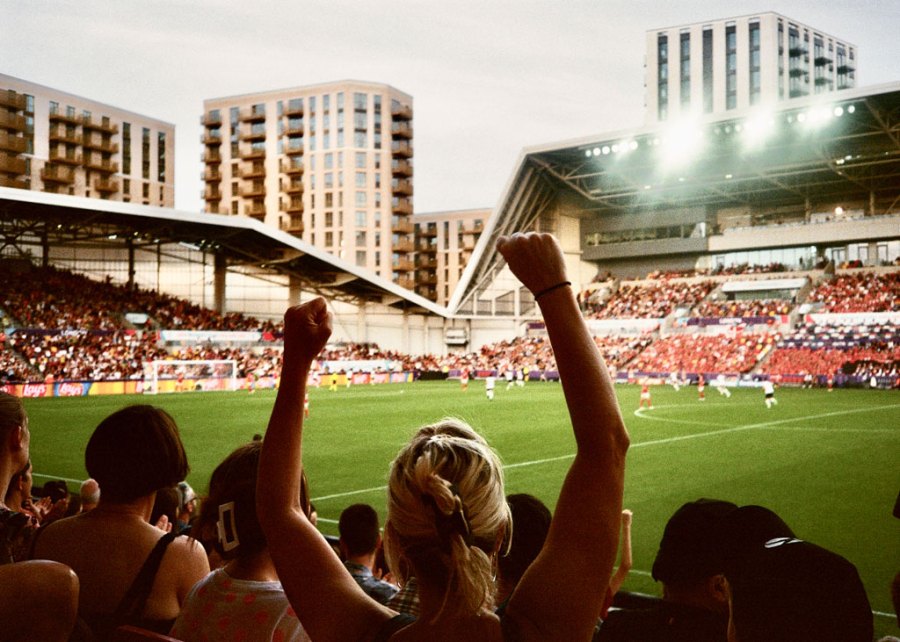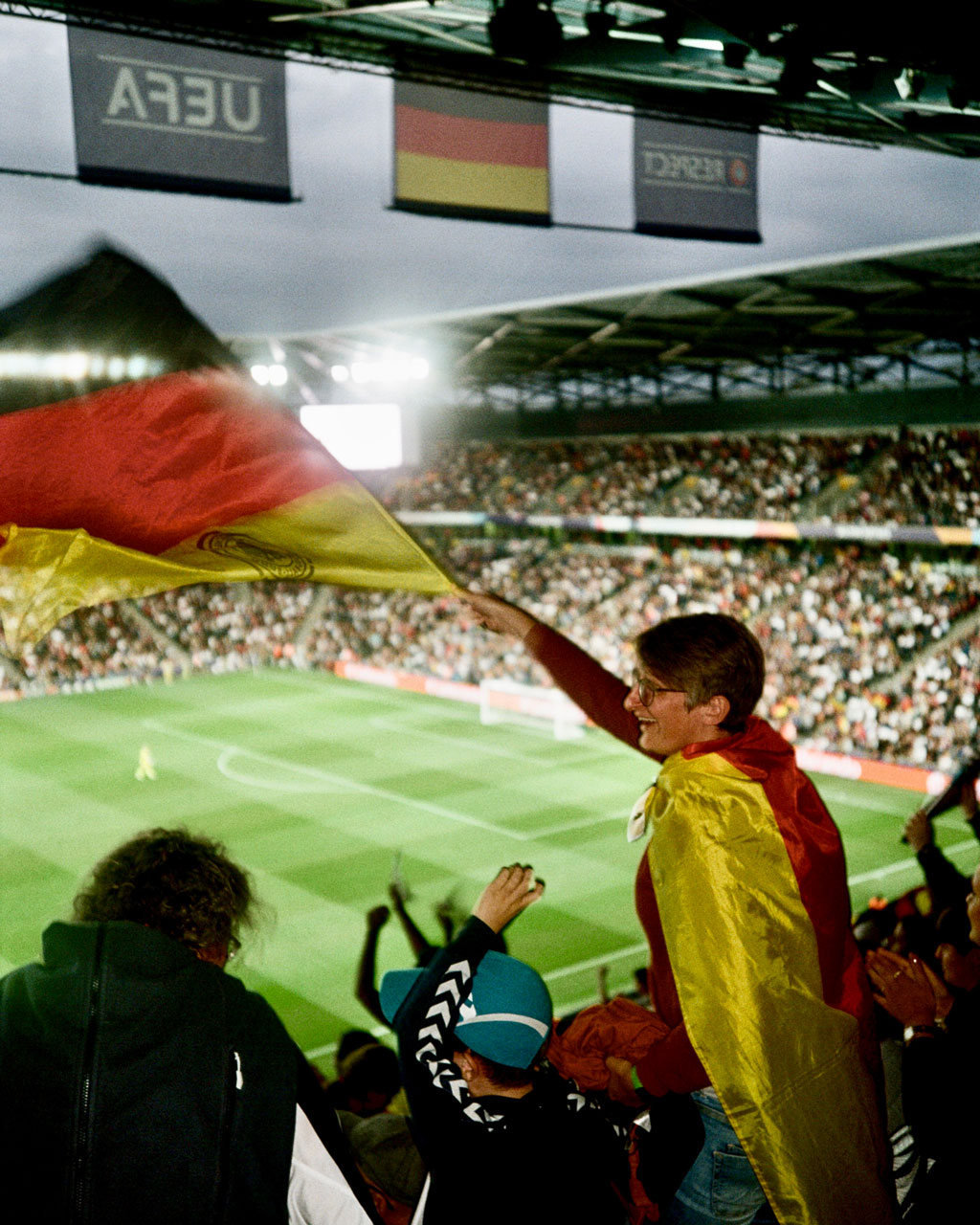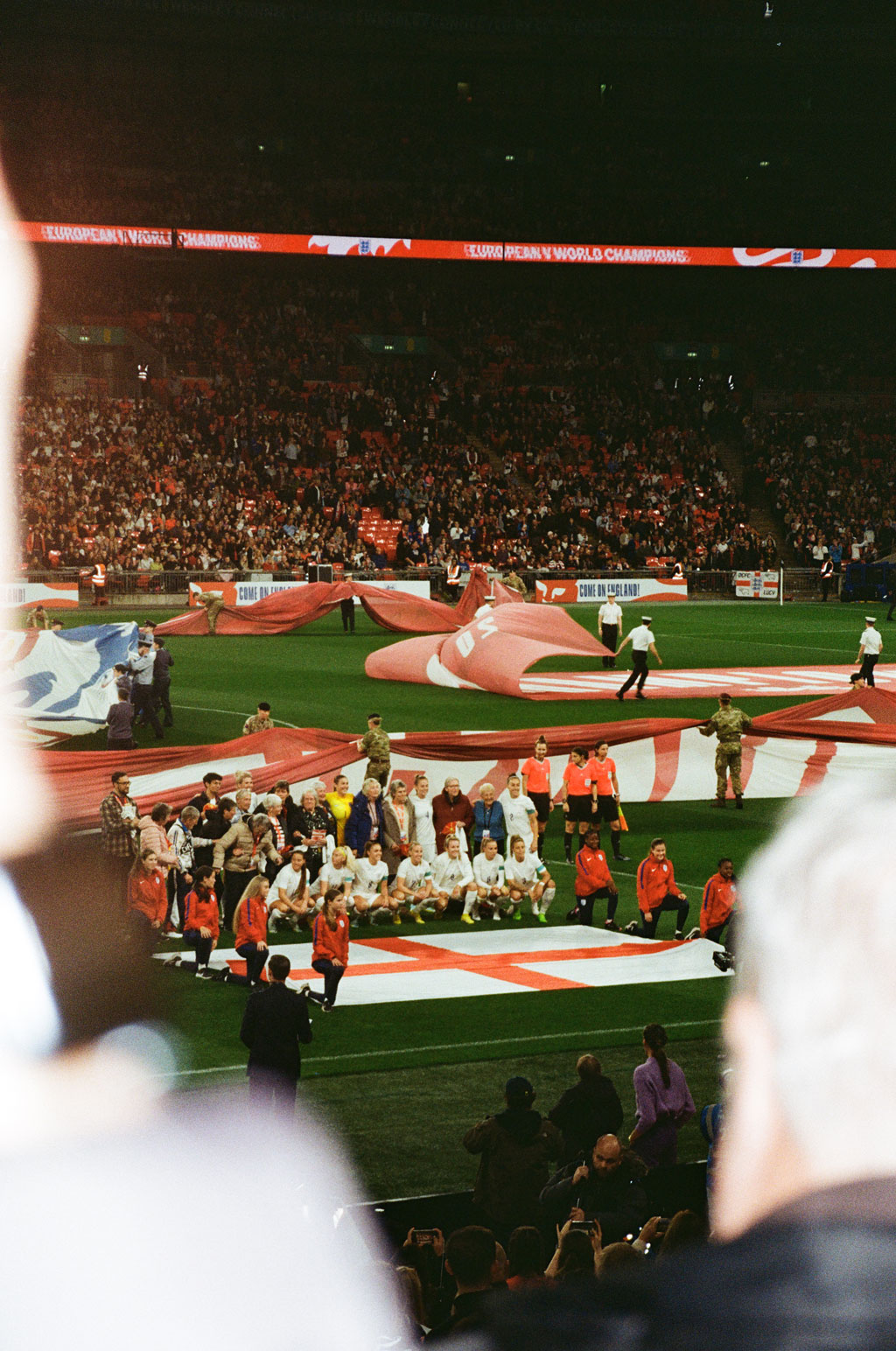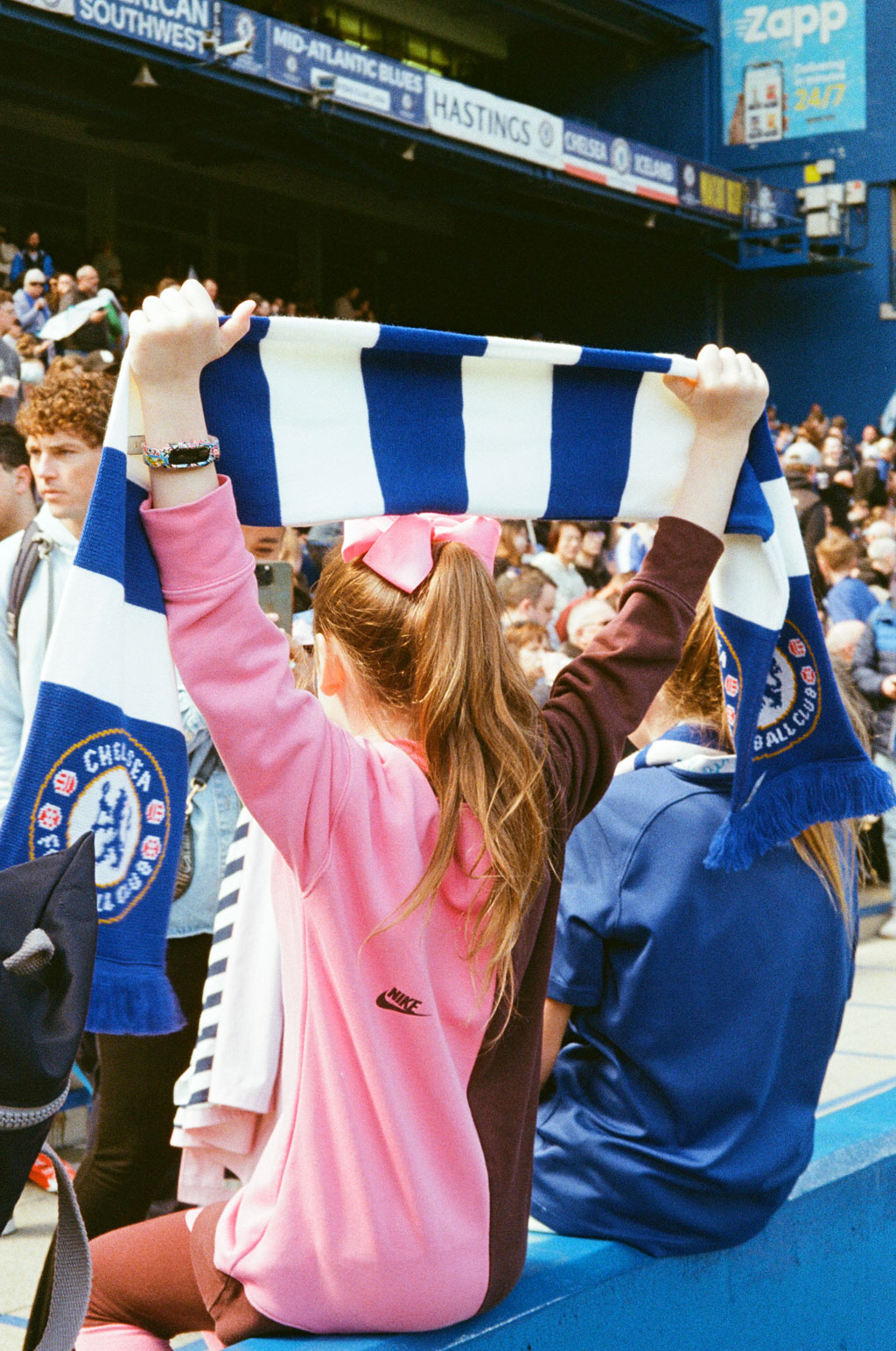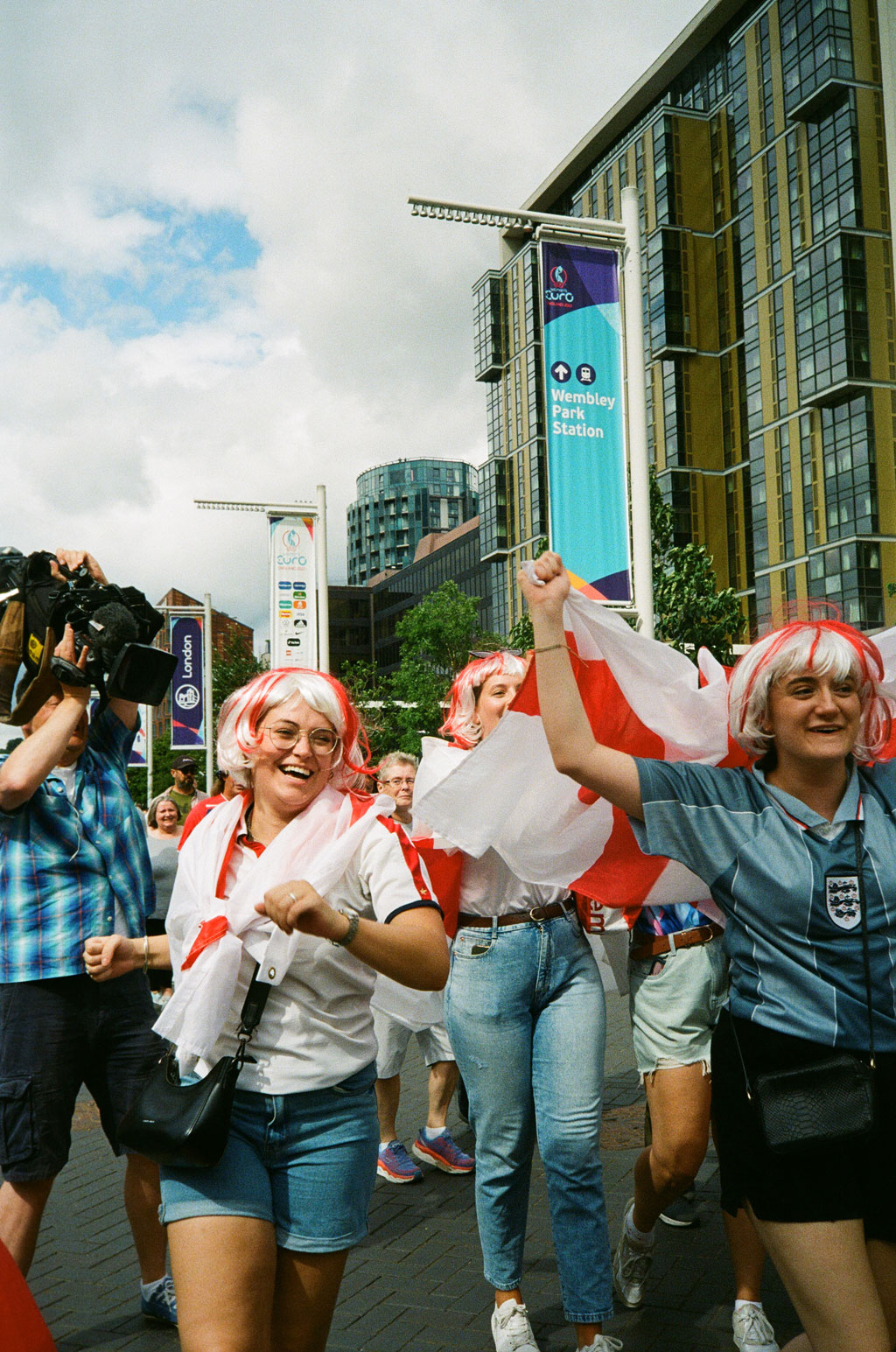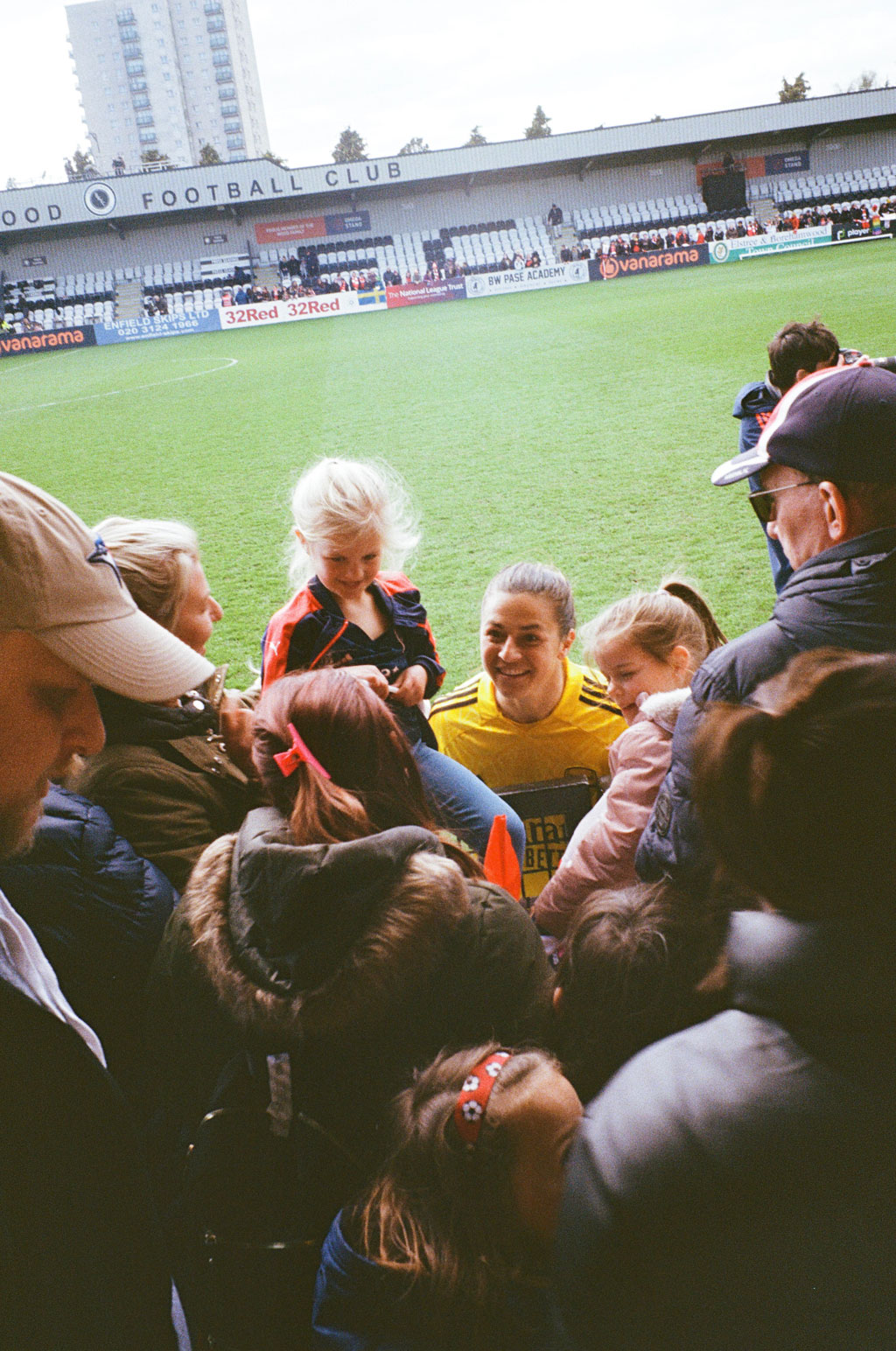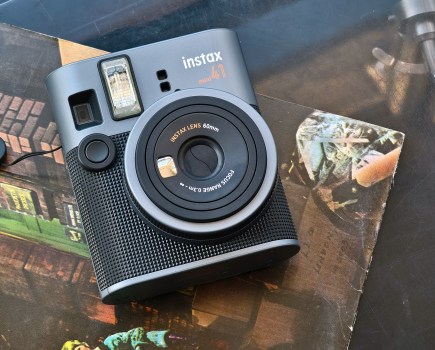We talk to Raiyan Rafiq and Harriet Duffy, two young female photographers who specialise in photographing women’s football on analogue film cameras.
Gen Z has long established itself as a nostalgic generation, one that yearns to capture moments, big and small. In a time when stills and video can be captured in near perfection, authenticity and the emotional resonance of a moment appear key and this is reflected in recent trends like the ‘video your life as a Wes Anderson film’ trend.

England and Brazil face off at Wembley Stadium as a crowd of fans watch on, photo taken on Kodak Gold film. Photo credit: Harriet Duffy.
Many young photographers have taken to using film and even vintage digital cameras to document the world around them, rather than the countless mirrorless cameras with an ever-growing number of megapixels available to them nowadays.
Another thing that has seen a surge in recent years is women’s football, particularly in the UK with the Lionesses’ victory at the 2022 Women’s UEFA European Championship and successful run at this year’s Women’s World Cup culminating in making it to the final match against Spain. Raiyan Rafiq and Harriet Duffy are two young photographers (and women’s football fans), both 25, who have been documenting this rise of the women’s game in the UK since last summer – focusing on the fan experience – on analogue cameras.
Sports photography is probably not the first genre you’d think of for doing film today, especially as film cameras can be unreliable and film itself is increasingly pricey.
Film photography and the power of capturing moments in sports – Harriet Duffy
Harriet Duffy’s photography journey began with her fascination with capturing moments. She says, ‘I like the idea of being able to look back on a place, a relationship or a sporting event and be able to remember the feeling at the time in which an image was captured.’
In 2014 she stumbled across her parents’ old Olympus Trip 35 compact camera, which she found was a perfect introduction to film photography given that it wasn’t overwhelmingly full of functions and settings. Since then, film has been her medium of choice. Why? The lengthy development and scanning process plus limited number of shots don’t faze Duffy, who explains that it is exactly this that reiterates her love of film.

Scenes from the terrace after England opened the scoring in the UEFA Women’s Euros final against Germany at Wembley Stadium. Photo taken with an Olympus Mju and Fujifilm Superia 200 film. Photo credit: Harriet Duffy.
Following her graduation from university last summer, she was commissioned to photograph the 2022 Women’s UEFA European Championship and stood pitchside in Wembley as England’s women’s team won England its first major trophy since 1966 when the men’s team won the World Cup.
Duffy believes that incorporating film photography into women’s football ‘helps increase the creativity of the game off the pitch. The more interpretations of football the better.’
She currently works as a freelance photographer and writer specialising in women’s football, shooting film at matches for independent outlets like Copa90 and Indivisa. She has even been commissioned to document the fan experience on the grounds of the UEFA Women’s European Championship with a Fujifilm Instax Square 1 camera which she enjoyed a lot, saying, ‘Whilst yes, it’s instant, you’ve still got to wait a bit for it to develop, meaning endless conversations with the subjects about the nostalgia of the camera.’
And for Duffy, this made it the perfect camera to document women’s football fans during that Euros tournament as it ‘highlighted just how euphoric that month was’.
As to what’s usually in her kit bag, Duffy explains that she’s limited due to the ‘A4-size bag only’ rule at football games in England. ‘If I’m in the stands I tend to just take my Mju I and three rolls of film but if I’m pitchside it’ll be my Canon AL-1, Olympus Mju I and Canon EOS 300 with five rolls of film. I tend to limit my shooting to two rolls per game to keep the costs down and ensure no frame is wasted.’
If given the choice to choose one camera and one type of film for the rest of time, however, she’d go with the Olympus Mju I with Kodak Gold 400 film that have become her go-to kit to have in her bag: ‘Having something so readily available when I’m on the move, weaving in and out of fans, is invaluable to capturing the true atmosphere I encounter.’
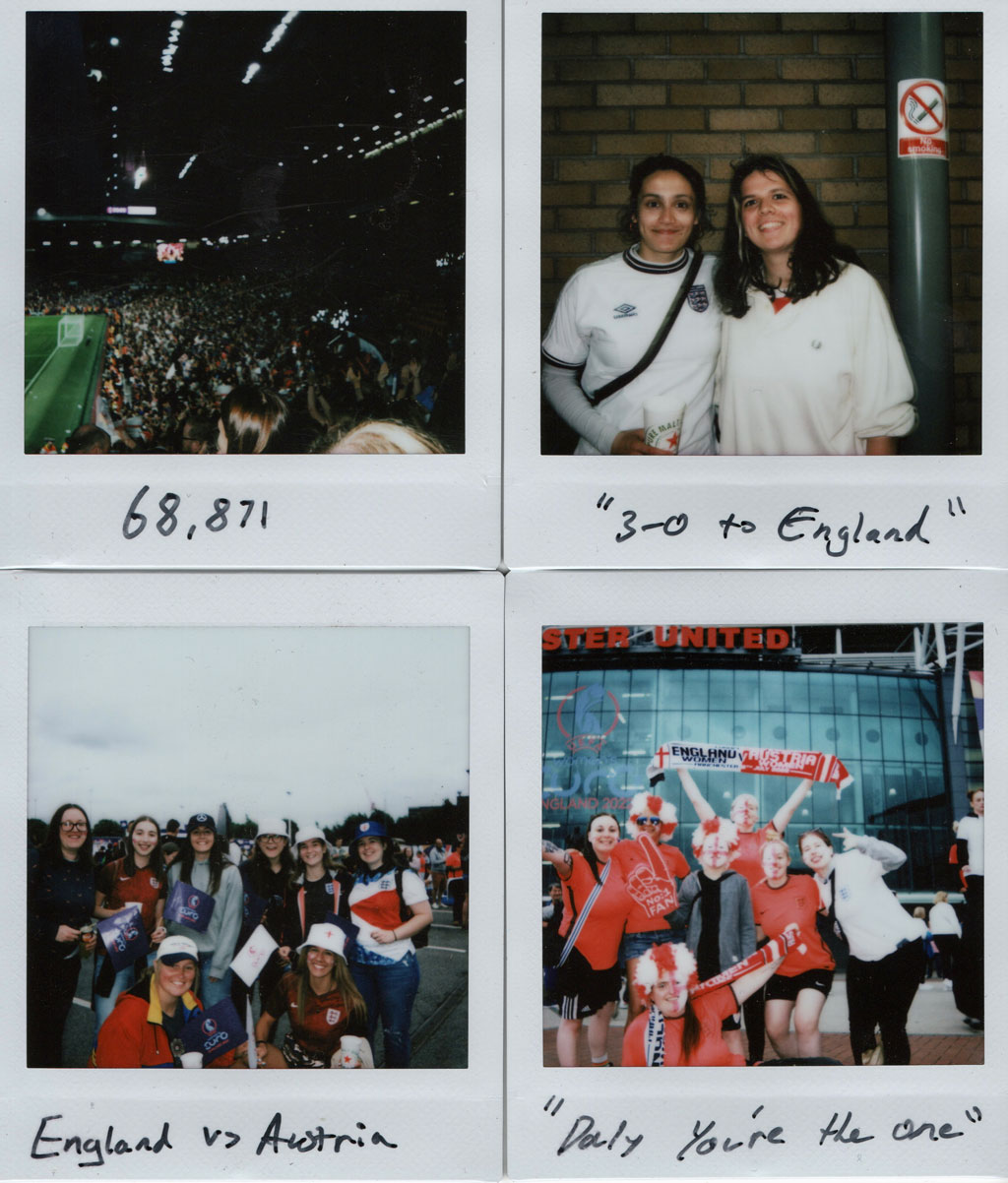
Some of Duffy’s Euro ‘22 instant photos taken with a Fujifilm Instax Square 1 for the opening game of the UEFA Women’s Euro between host nation England and Austria taking place at Old Trafford, Manchester. Credit: Harriet Duffy.
Street photography is her favourite genre, as she likes to ‘document things naturally because authenticity in representing women’s football is so important to me due to my passion for the game’.
Football player turned sports photographer – Raiyan Rafiq
Raiyan Rafiq, like Harriet, is a freelance photographer working predominantly in women’s football, as well as an avid football fan. She will also be studying for a postgraduate degree in law soon.
She began taking photos at high school tournaments but didn’t take it too seriously at the time as she was a player herself. After she moved to London from Bangladesh, Rafiq struggled with the pressure of university and learning to live abroad alone but after her father encouraged her to combine two activities she enjoyed – photography and football – she started attending matches in person.
And this is how she got into sports photography in the UK. ‘Before the Euros, the attendances were not very high so the security was relaxed, and we could take our cameras and lenses,’ she says. Last summer she was commissioned to photograph the Women’s UEFA European Championships by Indivisa and was also there to see the Lionesses’ historic win.
She described this as a ‘dream’ and a ‘full circle moment’ especially as she enjoys ‘capturing photos that tell a story or evoke emotions in a certain moment or time’, citing photojournalism and event photography as her favourite genres.
Rafiq blends digital photography with film photography too, depending on who she’s shooting and when she’s shooting. ‘If there is an indoor event, then I will probably rely on digital as not everyone likes the flash from a film camera – they can often be quite overpowering,’ she says. It also depends on the type of shot she’s after. She says that while she might capture the match itself on digital, ‘I prefer to capture the atmosphere and fans on film.’
For her, the nostalgic quality of film is a given. Then there’s the film aesthetic, she says, the unique contrast, tonal range or grain a film photo has that you can’t replicate digitally. There is also the need to be patient. ‘We get everything so instantly nowadays that it takes the experience of anticipation out of it. Film is exciting because you don’t get a result immediately.’ She likens the experience to opening presents on your birthday.
For Rafiq, film cameras, much like other gadgets from the 1990s and beyond that have returned from the dead, such as vinyl, Walkman, and typewriters, present a hands-on experience that makes them more endearing. ‘You need to learn about the device before you can use it, instead of just powering it up and clicking a button,’ she says. ‘So, in a way you feel more in tune with your devices, as clichéd as that may sound.’
On a regular shooting day, Rafiq carries a digital camera, the Canon EOS 600D, as well as two film cameras, a Canon 5000 and a Pentax point and shoot. These are usually joined by a 300mm telephoto zoom lens and three to four rolls of film. ‘Because the weather in this city is always so unpredictable, I have started carrying a rain cover’ she adds.
Her favourite film camera, however, is also the Olympus Mju I. She says, ‘I loved the camera so much when I picked it up a few years back and instantly fell in love with it. The size is perfect, and the quality is amazing. Thus contributing to my username on Instagram, RaWithAMju’. As for film, for her that prize goes to the Kodak Ektar 100, ‘the contrast is always so brilliant and the colours pop out so well. It’s incredibly smooth but at the same time retains the feel of a film.’
Sports photography on film – how to get started
Her advice? ‘Start small and then move up.’ Rafiq recommends beginners start with a point and shoot and then switch to more analogue cameras, ‘You need to learn to fall in love with the process or else you will end up spending money on a camera you barely use’. She also points to YouTube as a great place to learn from other photographers who go through the technicalities, what cameras to buy, how to use them and more.
‘I also think you have to be open to failing a lot. Some days, I have taken only twelve good pictures out of thirty-six and while that can understandably be frustrating, it has also helped me get a grip on the dos and don’ts. Most importantly, love what you capture. Document the things you love, and the photos will speak for themselves.’
Harriet’s biggest advice would be to go out and shoot as much as possible. ‘I was lucky in that I started shooting film when Agfa Vista was available for £1 in shops meaning I could learn from experimentation and experience. With film costs being extortionate now I recognise that that’s a privilege today but it’s nice seeing new people come into the industry to try and counter the costs such as Candido.’
At the moment, Duffy is getting ready for the new European domestic football season which will be starting in October. ‘I’ll be back in the stands and the pitchside capturing what’s set to be one of the biggest years for the Women’s Super League after the tournament the Lionesses just had’.
Rafiq is heartbroken at not being able to go to Australia to watch the Women’s World Cup. She is taking a break from sports photography before the WSL season starts anew. ‘I am trying to capture more everyday living through photos. Trying to fall in love with the minute, ordinary things’.
Follow Harriet Duffy and Raiyan Rafiq on Instagram to see more of their work.
Related content:
- How to shoot action and sports photography
- How to do film photography on a budget
- Top tips for how to get creative with analogue film photography
- Complete guide to Portrait photography – How to get started
Follow AP on Facebook, Twitter, Instagram, YouTube and TikTok.

